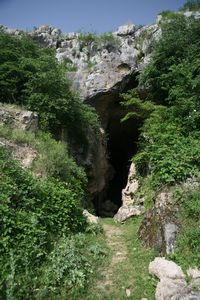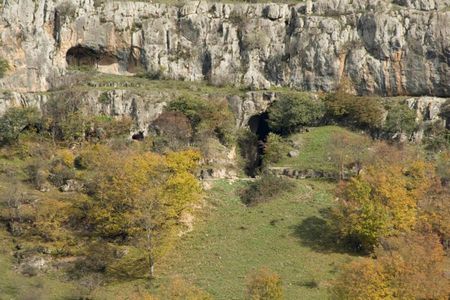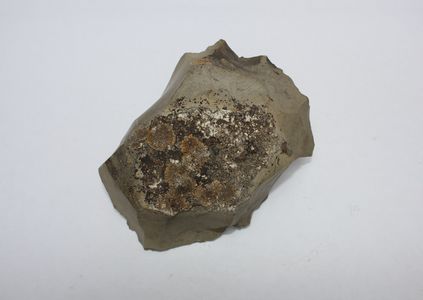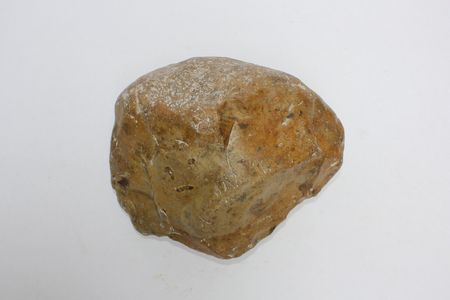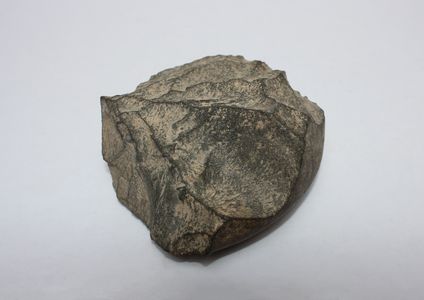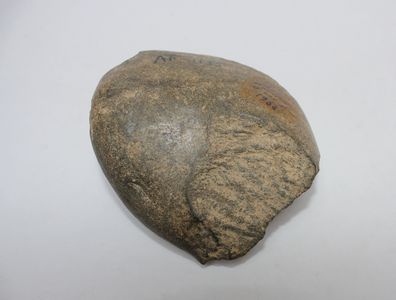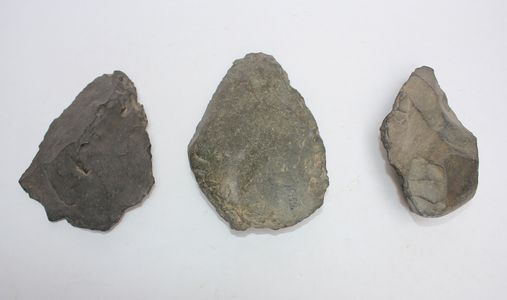THE MOST ANCIENT HUMAN HABITATION: AZIKH
Paleolithic period (in Greek, παλαιός “old”, λίθος “stone”) means “old stone” age. It extends from about the beginning of human existence to the 13th millennium BC. This age is divided into three periods: the Lower Paleolithic (1, 5 million- 100 thousand years ago), the Middle Paleolithic (100 thousand-40/35 thousand years ago), the Upper Paleolithic (40/35 thousand years ago- the 13th millennium BC). In the Old Stone Age people firstly lived in herds, later in tribal communities engaging in gathering and hunting. Prehistoric people made their tools and weapons from stone and wood and gradually upgraded them. More than thirty Paleolithic caves and settlements were found in the territory of Azerbaijan. The most ancient one of them is Azikh Cave.
Primitive society, including lifestyle of ancient people, their evolution was researched by means of the Paleolithic settlements and material cultural examples found during archeological excavations there. One of such ancient human habitations is Azikh Cave, Paleolithic settlement that was registered and archaeologically studied by Azerbaijani archaeologist Mammadali Huseynov in 1960. The habitation is located in Guruchay valley of Karabakh, 3 km far away from river, in its modern river-bed at 200-250 meters altitude. The settlement composed of the cave is situated between Azikh and Salaket villages, at 950 meters altitude above sea level. Azikh Cave is considered the most incredible karst cave for its hugeness in the Caucasus. The cave with 230 meters length consists of five halls. Along with small exits and karst well, the cave is in length of 60 meters. Azikh is a karst cave with a bit more than 1250 square area in general. During 1960-1987, archaeological excavations were carried out in the south entrance and the first hall of multilayered Azikh Paleolithic habitation. Ten archaeological layers were revealed in the south entrance during archeological excavations. Total thickness of residue is 13.5 meters. The layers consistently reflecting all periods of Paleolithic Age were uncovered in the remains of settlement. Thus, material examples and bone remnants were found from the first layer concerning Middle Ages, Bronze Age and Eneolithic Period and from the last 10th layer relating to the earliest periods of Paleolithic Age.
GURUCHAY CULTURE
The most ancient archeological findings relating to historical period were revealed from 7th-10th layers of Azikh Cave. More than 300 stone products were found from these layers. The greater part of the tools is rough chopping tools. There were rigid hatchets, cubic tools, currycombs, fragments with well-preserved surface among stone products. These materials give information about the first dwelling of ancient people in the cave. Guruchay River near the cave had a necessary role in prehistoric humans’ life. Therefore, the material cultural remains of new archaeological culture discovered in the 7th-10th layers of Azikh Cave were named after Guruchay. While in the early period of the culture tools were made in a simple way, later tool making techniques were improved and new tools began to be made. The tools of Guruchay culture found from the 7th-10th layers of the ancient human habitation Azikh are similar to Olduvai culture of East Africa. However, there were distinctive features in the typology of the tools that had led to the discovery of new archeological culture on the basis of the materials of lower layer of Azikh. As result of complex scientific researches, it was identified that Guruchay culture in Azikh began 1.5-1.2 million year ago and ended 700 thousands years ago.
GIGANTOLITE
A giant tool weighing 4-5kg found from the 8th layer draws the attention among the stone tools discovered in Azikh Cave. Such stone tools are conditionally called “gigantolite” or “chopping-gigantolite”. In general, such kinds of three stone tools were uncovered in Azikh that one of them is displayed in the exposition of the Museum. This tool informs us of the first settlement of ancient people and their occupations.
HEARTH PLACES
Hearth places discovered in the 6th, 5th and 3rd layers of multilayered Azikh Cave are regarded one of the interesting findings. It shows that inhabitants of the cave mastered the fire, the greatest natural energy, too early (after Guruchay culture) and managed to preserve it for a long time. Five fire places burned in different millenniums were detected in Azikh Cave. The hearth began to be fired in this cave 700 thousand years ago. The oldest hearth place was found in 6th layer in 1973 and the biggest one in the 5th layer. The greatest hearth place was in form of the letter “L” and encompasses 10 square meters area. More than 150 kg of real ash and coal was piled there. There was a wall of ash on both sides of the fire. The thickness of ash was more than a meter. The great amount of fire, ash and coal, a wall of ash around the fire and so on are the unique findings in the world.
OCCUPATION OF PREHISTORIC HUMANS
Gathering
Gathering played a main role in the agriculture of prehistoric humans in the Old Stone Age. Stone Age people met their dialy demand for food by gathering green vegetables, mushroom, peanut, wildings and different fruits. Plant roots were pulled out with digger tools made from wood and stone; cereals were gathered with picking knives. Intensification of the gathering, in turn, brought about cultivation of cereals. All of these paved the way for transition to the formation of producing industry.
Hunting
Hunting had a specific place in consumption industry of prehistoric humans of the Old Stone Age. Thousands of hunted animal bones were found in the prehistoric human habitations. More than six thousand hunted animals bones were uncovered in the 3rd layer of Azikh Cave. There were plenty of horse, bull, wild onager, Caucasian deer, wild boar, cave bear, rhinoceros and other animals bones among them. These findings prove that hunting played a vital role in the occupation of inhabitants.
Besides hunting, fishing was also a part of consumption industry of the Old Stone Age.
STONE TOOLS
Among the material cultural examples of the Old Stone Age, stone tools draw special attention. Stone products of ancient Acheulean period are charactirezed by hand axes made in a basic way, rough chopping tools, tools made on thick fragments and disc-shaped nucleus. Making hand axes played a crucial role in the life of prehistoric people. Thereby, they began to develop hunting. The main tools of ancient Acheulean period are ground digging and currycomb-typed tools.
Beginning from the Middle Paleolithic - Musterian culture period (100-35 thousand years ago) prehistroic humans began to make novel tools. It was associated with their evolution. Rough chopping tools, hand axes, the tools made in previous times, did not meet their demand and made the making of better tools the main priority.
In the Upper Paleolithic period, oblong knife-shaped flint boards were made from prismatic nucleus in novel technical ways. Those boards were used to make currycomb, blades, awls, pikes etc. Most of these tools had bone or wood handles.
PREHISTORIC BELIEFS
Progressive changes were occurring in labor process, essence of humans themselves, their sense organs, ability, mentality, speech, cognition of the environment and so on. This change had already been occurring in early stages of the development of prehistory- early Acheulean period. All these changes affected the prehistoric beliefs and outlook. In Azikh Cave there was detected a special, secret corner where four bear skulls were preserved. There were several carvings on the bear skull found in Azikh Cave. Seven carvings among them are in parallel form. The approved fact of “cult of skull” in Azikh indicates the emergence of the earliest beliefs of Azikhantrop (Azikh Man) about the environment. Later, religious elements arose on the basis of those beliefs. Skull piles, totally animal bones are the indicators of totemism and its commencement.
